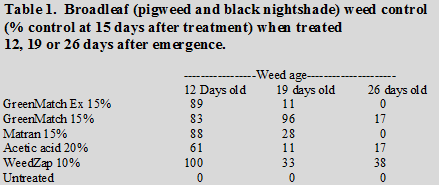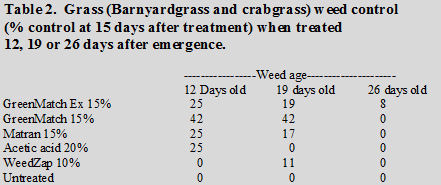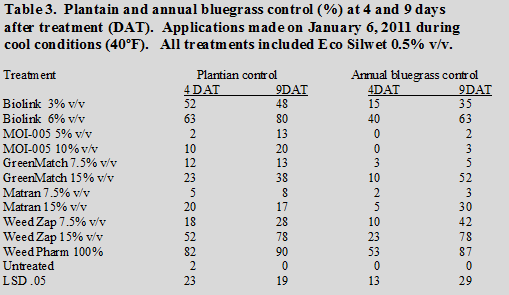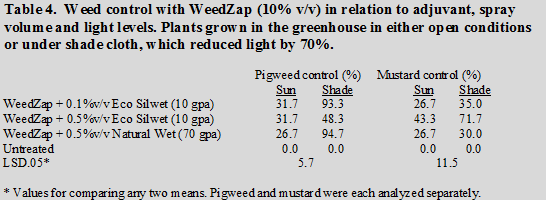Organic Herbicides - Do They Work?
by W. Thomas Lanini
Weed Control and Selectivity
Organic herbicides kill weeds that have emerged but have no residual activity on those emerging subsequently. Further, while these herbicides can burn back the tops of perennial weeds, perennial weeds recover quickly.
These organic products are effective in controlling weeds when the weeds are small but are less effective on older plants. In a recent study, we found that weeds in the cotyledon or first true leaf stage were much easier to control than older weeds (tables 1 and 2). The control ranged from better than 60% to 100% if these weeds received high volumes of these materials when they were just 12 days old. When broadleaf weeds were 26 days old, even high volumes of these materials gave at best less than 40% control.


We also found that broadleaf weeds were easier to control than grassy weeds — the best control on even young, 12-day-old grass weeds was only around 40 percent. This may possibly be due to the location of the growing point (at or below the soil surface for grasses) or the orientation of the leaves (horizontal for most broadleaf weeds).
All of these materials are contact-type herbicides and will damage any green vegetation they contact. However, they are safe as directed sprays against woody stems and trunks. For turfgrass sod production, organic herbicides could be applied when preparing the seedbed and then again with the first flush of weeds. Grass seed could be planted a bit deeper (1/4 to 1/2 inch deeper) to delay turfgrass emergence, so that the organic herbicide could control the broadleaf flush without adversely affecting the turfgrass.
Application
Organic herbicides kill only contacted tissue so good spray coverage is essential. For example, a large, flat nozzle (e.g. 8006) would be preferable in turfgrass production. In tests comparing various spray volumes and product concentrations, high concentrations at low spray volumes (20% concentration in 35 gallons per acre) were less effective than lower concentrations at high spray volumes (10% concentration in 70 gallons per acre). Because organic herbicides lack residual activity, repeat applications will be needed to control new flushes of weeds.
In addition to high volume, we found that adding an organically acceptable adjuvant resulted in improved control. Among the organic adjuvants tested thus far, Natural wet, Nu Film P, Nu Film 17 and Silwet ECO spreader have performed well. Although the recommended rate of these adjuvants is 0.25 % volume per volume (v/v), increasing the adjuvant concentration up to 1% v/v often leads to improved weed control, possibly due to better coverage. Work continues in this area, as manufacturers continue to develop more organic adjuvants.
Environmental Conditions
Optimum environmental conditions are required when applying these organic products for good control of weeds. Temperature and sunlight have both been suggested as factors affecting organic herbicide efficacy.
In several field studies, we observed that organic herbicides work better when temperatures are above 75° F, so applications in the winter may be less effective than summer applications. However, recent experiments have assessed winter weed control during cool conditions (table 3), and in spite of cold temperatures, plantain control was very good with Weed Pharm, or the high rates of Weed Zap or Biolink. Annual bluegrass control was also good with these same materials during cool conditions.

Sunlight has also been suggested as an important factor, and anecdotal reports indicate that control is better in full sunlight. However, in a greenhouse test using shade cloth to block 70% of the light, we found that weed control with WeedZap improved in shaded conditions (table 4). The greenhouse temperature was around 80° F, so it may be that sunlight is less of a factor under warm temperatures.

Economic Considerations
Organic herbicides all work if you have enough volume and concentration to directly contact the weeds. However, these herbicides are expensive and may not be affordable for commercial crop production at this time. Cost in 2010 was about $400 to $600 an acre for broadcast application, which may be considerably more expensive than hand weeding. Moreover, because these materials lack residual activity, repeat applications will be needed to control perennial weeds or new flushes of weed seedlings. We see these herbicides eventually being used commercially with camera-based precision applicators that “see” weeds and deliver herbicides only to the weeds, not to the crop or bare ground.
W. Thomas Lanini is Cooperative Extension Weed Ecologist, Department of Plant Sciences, UC Davis.












